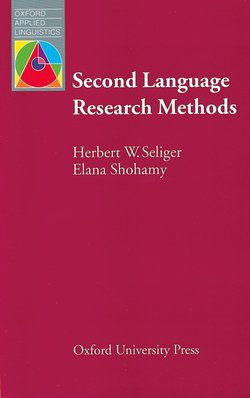Читать книгу Second Language Research Methods - Herbert W. Seliger - Страница 3
Introduction
ОглавлениеWhat this book is about
It is evident to anyone reading research in second language acquisition, that the field is inter-disciplinary. The study of second language acquisition can be linguistic, psycholinguistic, sociolinguistic, sociological, psychological, and educational. That is, it draws on a wide number of perspectives about the phenomena of second language as well as the research methodology associated with these different disciplines.
We have tried to give equal focus to a variety of approaches to research in this book but realize that we could not hope to describe all the possible methods or all of the possible types of research. We have, therefore, tried to describe what could be considered paradigmatic types and principles of second language research. The possible designs of research in second language are only limited by the ingenuity of the researcher and the conditions under which the research is being conducted.
The purpose of this book is to introduce the process of carrying out research in second language acquisition and bilingualism. The book is aimed at those who are new to second language research, or who may have done some research without guidance. It is intended for graduate and undergraduate students in courses in research methods and design, specifically in second language acquisition, bilingualism, and applied linguistics.
As the reader of this text gains experience in the process of conducting second language research, he or she will discover that such research is conducted in a wide variety of environments, natural and formal, with subjects of different ages and with a wide variety of goals and underlying theories.
The text discusses second language research from the conception of research questions through the development of research designs, data-gathering procedures and data analysis. However, we have not provided recipes for carrying out research but have taken the approach that if the reader understands the principles involved in the unique and varied conditions of second language research, he or she will be able to analyze a research problem and develop an appropriate methodology and design.
As will be evident from a review of the table of contents, this book does not deal with statistics except in a very limited way in Chapter 9. Statistical procedures should not be confused with the thought that must go into research method and design. We felt at the outset that what is not needed is another book on statistics. Several good texts on statistics are already in existence and we have given a reference list of some of them in the Appendix. Chapter 9 gives an overview of some of the more common data-analysis procedures which are used in second language acquisition but we strongly recommend that anyone intending to pursue second language research acquire a more in-depth knowledge of statistical procedures for research.
The table of contents reveals that we have focused on the preparatory stages of conducting research, since we feel that it is only with careful and fastidious preparation that good research can be carried out. It has been our experience both as active researchers in second language and as members of thesis and dissertation committees, that the first stages of exploring the ideas for research and developing the structure of the actual study are, without doubt, the most important. To paraphrase the Buddha’s teachings: if the builder of a house finishes his work with the finest roof but the house rests on a poorly constructed foundation, the roof and all that is under it will collapse.
The research cycle
A common thread which unifies this text is the idea that research is cyclical. It is an ongoing activity which is never totally completed because each piece of research raises additional questions for more research. Either the results lead the investigator on to related questions or the original question or hypothesis with which the research began cannot be answered or confirmed and the investigation must begin again but with a gain in knowledge and experience.
We have tried to give expression to the essentially cyclical nature of research in the way we have structured this book. It has been organized so as to reflect the cyclical nature of the research process itself.
The research cycle and the organization of the book
The parameters of second language research
The conceptual foundation of this book is found in Chapter 2, where we describe a research framework consisting of four parameters that encompass the unique features of research in second language. These parameters describe different aspects of second language investigation and constitute a useful taxonomy for categorizing, describing, and evaluating second language research. Throughout the text, we refer back to these four parameters because they enable us to view research design and method from a more unifying and coherent perspective.
How to use the book
Each chapter contains a set of activities based on the content of the chapter and intended to concretize some of the main ideas of that chapter. Carrying out second language research requires thinking and doing. In this sense, the chapters, with their accompanying activities, are meant to complement each other so that the text becomes both a discussion of second language research and a ‘field manual’ for research-like activities. Some of these activities require the reader or student-researcher to consult other texts and journals. Still others require a ‘hands on’ approach to constructing designs, developing instruments, and so on. These activities are intended to supplement the content of the chapters in which they occur, and to help the reader to think and experience rather than simply read and go on to the next chapter.
